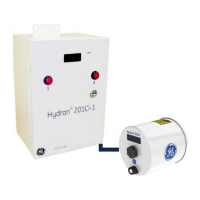6.2.1 Tools and Material Required
• Flat-blade screwdriver.
• General Electric’s Hydran 201TW tube wrench to tighten the Hydran 201 sensor.
• Pipe wrench to tighten the brass adaptor onto the valve.
• Allen keys supplied with the Hydran 201Ti (see Section 7.1.1).
• Bucket and oil-absorbing rags.
• Teflon tape and vinyl tape.
• Drill, bits and fasteners for mounting the Hydran 201Ci Controller.
• If required, vibration-absorbing rubber pads, which can be purchased from
General Electric.
• Conduits, fittings and cables for power supply, alarms, analog outputs and
communications.
• Digital voltmeter/ammeter.
6.2.2 Mounting Location of the Hydran 201Ti
A Hydran H201Ti monitor can be installed on any available transformer valve.
However, care must be taken in selecting a suitable location while respecting the overall
dimensions and weight of the monitor. To achieve optimal performance from the
monitor, ensure that:
• the monitor is mounted horizontally on the transformer valve
• there is no restriction between the Hydran and the main body of oil
• there is a good circulation of oil flowing towards the Hydran.
6.2.2.1 Requirements
1. Always mount the H201 sensor on a full-bore gate or ball valve where there is
sufficient convective oil flow.
2. The H201Ti is installed on a valve with a 1.5-in nominal diameter (NPT female
threads). If necessary, use a reducing bushing.
Note: To ensure sufficient oil flow past the sensor’s membrane, the nominal diameter
of the valve should never be less than 25 mm (1 in).
3. The total distance between the H201Ti and the mounting point of the valve must
not exceed six times the nominal diameter of the valve (230mm [9 in] for a 38mm
[1.5in] valve). See Figure B-1.
4. The body of the valve must be grounded.
5. The H201Ti weighs 5.6kg (12lb). If the selected valve is subject to strong
vibrations, install a supporting bracket to reduce the load on the valve. In case of
doubt, consult your engineering personnel.
6. Ensure there is enough clearance above and below the Hydran H201Ti to
separate it from its sensor.
7. The Hydran H201Ti must always be easily accessible.

